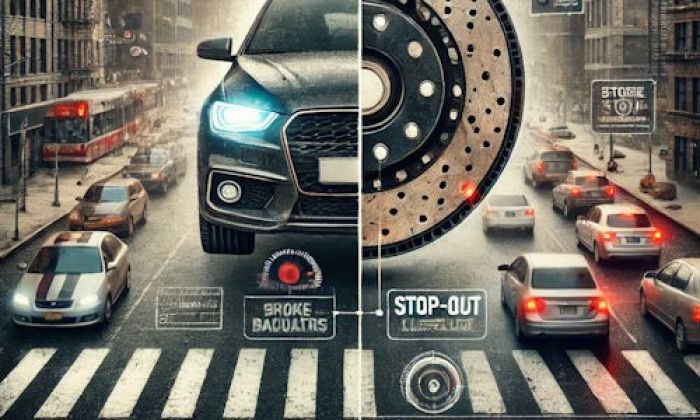The P2097 code usually means that there is a leak in the exhaust or the oxygen sensor is malfunctioning. But in Chevy vehicles, it very often appears because of the software issue. There is a software glitch that misinterprets the data from the oxygen sensor and starts signaling about its failure way before the problem actually develops.
P2097 code highlights
- Level of urgency:Medium
- Possible culprits:Fuel supply, air supply, ignition system, emission sensors
- Price for repair:$300 - $600
- If neglected:Failing emission test, dead catalytic converter, poor efficiency
- DIY repairs:Impossible
- Can you drive?Yes

The P2097 code - what should you know about it?
This code originally shows that the oxygen sensor that is located right after your catalytic converter registers a high volume of unburned fuel or some other anomaly that shouldn't be there. Given this is an emission-related code, it's pretty important because with this code you won't be able to pass a smog test.
The code will trigger the check engine light. It won't necessarily change the behavior of your vehicle (most likely, it won't change it at all). But it doesn't mean that you should just ignore the code.
Here are the actual situations that may trigger it:
- the heavy engine misfiring leads to fuel being burnt in the converter, so the temperature goes up and the emissions are not OK;
- there is a leak in the exhaust system and the oxygen sensor registers this as the anomaly in the amount of emission gases;
- the oxygen sensor itself may be broken and need replacement - usually, this happens because of its age or overheating;
- also, this problem may arise when the catalytic converter is not efficient enough, so it needs replacement or cleaning.
Bank 1 means that this problem happens in the part of the engine with the first cylinder. For any in-line engine, this is the only bank available. But for the V6 or V8, Bank 1 will mean that you should check the exhaust system in the Bank 1 part of the engine. So, understanding this will save your time and resources.
Unfortunately, there is one more big thing that can trigger this problem. This is the software. And this is exactly what you should check in a Chevrolet vehicle.
P2097 in your Chevy - what's this?
If your Chevrolet vehicle shows the P2097 code, it's not necessarily a problem with the converter or with the oxygen sensor. Unfortunately, if you come to an independent repair shop, the mechanic will most likely start with replacing the expensive oxygen sensor, and then will look for other problems with the engine (and will obviously find them). And this will cost you quite a lot of money.
In a dealership, things may also go this way if you don't know what to ask for. First of all, remember that the exhaust system is covered by an extended warranty of 8 years or 80,000 miles (whichever comes first). This means, that you may get a free repair.
Also, there is a service bulletin that may allow you to repair your emission system free of charge even if the car is out of the warranty period. Of course, this repair will only mean upgrading the software. But this is exactly what can cause this annoying P2097 error code in your vehicle.
Chevrolet cars are known for throwing this code exactly because of the software glitch that can be corrected by any Chevy dealer for several minutes. The problem is that if you don't know about that, the dealer may still charge you for the software update, so you better tell them that you are aware of the service bulletin.
For the Chevy Malibu 2017, you will have the SB number 19-NA-017, for the Chevy Volt 2017, the SB number is 18-NA-047. But there are other cars - just browse the internet and find more info about your model.
What should you do when you get the P2097 code?
If you want to do something on your own, you can take these steps and check your car for some common problems before going to the dealership or repair shop:
1) Use the scanner for proper inspection.
You may want to use the OBD2 scanner to find some other codes. For example, if you get the P0300 code, you may be sure that the emission code is just the side effect of the engine misfiring problem.
2) Visually inspect the exhaust system
If there is a leak, you may locate it when the engine works and the car is on the lift so you can see the pipe, the converter, etc. Now, if you see any exhaust leaks or some damaged components here, you can bet this is the reason for the code.
3) Reset the code
You may reset the P2097 code with the scanner or by disconnecting the battery for 5-7 minutes. After this, the code may not reappear if the problem was with the software glitch.
There is nothing much you can do on your own if the problem is with the oxygen sensor or the catalytic converter. Usually, this may happen when the car already has over 100,000 miles on it and some exhaust parts may fail to work properly. Unfortunately, a broken converter may cost you pretty much to replace. So, you better check everything else thoroughly to make sure this is actually the converter.
If you can't locate the problem on your own, it's time to plan your visit to a repair shop. I strongly recommend going to the dealer for the inspection first because Chevy cars have a lot of tricky problems known exclusively for certain models. And dealers know about them, so it will take less time and money to locate the actual problem. What's more, you can solve the issue for free if your model has a service bulletin for this code.
Also, don't forget about the extended warranty for the exhaust system components that you can use even if your bumper-to-bumper warranty is over.
How do you understand if the problem is with the converter or oxygen sensor?
This is not that easy to understand. The converter will obviously throw different codes. It will also make the car sluggish gradually. You won't feel any sharp changes in the behavior of your vehicle, but over time, the changes will be very significant.
If the oxygen sensor fails, the changes in the behavior of your vehicle may not be noticeable at all or they may be pretty sharp. This is the only difference you can use to understand the problem.
The common reasons for catalytic converters and oxygen sensors failure are as follows:
- prolonged problems with the engine like misfiring, turbocharger issues, problems with too rich or too lean air-fuel mixture;
- overheating of the catalytic converter due to raw fuel getting in and then burning or exploding there;
- just time and mileage - on average, the converters live up to 150,000 miles while oxygen sensors may fail at 100,000 miles or even earlier;
- poor quality of fuel - bad fuel will obviously affect the lifespan of your emission system components;
- physical damage - the parts are located under your vehicle, so they may be damaged by hitting a rock on the road or something like that;
- vandalism - catalytic converters are often the targets of criminals because they cost some money, so there may have been an attempt to steal yours.
As you see, there are a lot of reasons that can lead to issues with the catalytic converter or oxygen sensor. Quite obviously, you may also find other issues and reasons for this.
Ghost codes in your Chevrolet
I should also tell you that Chevy vehicles really love throwing ghost codes. They are codes that mean that your battery is low or the alternator is not supplying the system with the proper voltage. If this happens, you may clear the code by the scanner or by disconnecting the battery for some time and the code will not reappear.
I've already written about some common but still mysterious Chevy codes like the C0800-03 code, for example. The codes in your Chevy will not always mean directly what they say in the scanner. You need to know what else can these codes mean to successfully deal with them.
About the authors
The CarAraC research team is composed of seasoned auto mechanics and automotive industry professionals, including individuals with advanced degrees and certifications in their field. Our team members boast prestigious credentials, reflecting their extensive knowledge and skills. These qualifications include: IMI: Institute of the Motor Industry, ASE-Certified Master Automobile Technicians; Coventry University, Graduate of MA in Automotive Journalism; Politecnico di Torino, Italy, MS Automotive Engineering; Ss. Cyril and Methodius University in Skopje, Mechanical University in Skopje; TOC Automotive College; DHA Suffa University, Department of Mechanical Engineering






Add comment